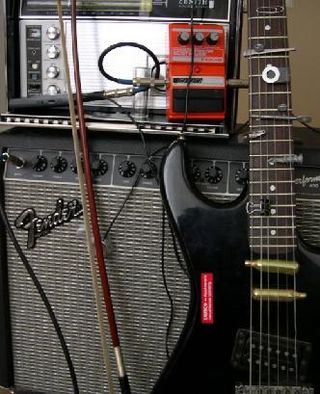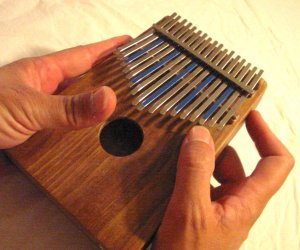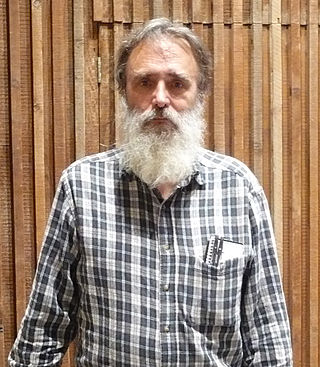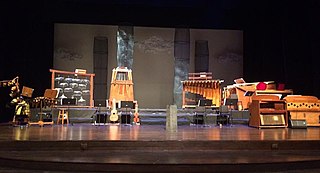Related Research Articles

A percussion instrument is a musical instrument that is sounded by being struck or scraped by a beater including attached or enclosed beaters or rattles struck, scraped or rubbed by hand or struck against another similar instrument. Excluding zoomusicological instruments and the human voice, the percussion family is believed to include the oldest musical instruments. In spite of being a very common term to designate instruments, and to relate them to their players, the percussionists, percussion is not a systematic classificatory category of instruments, as described by the scientific field of organology. It is shown below that percussion instruments may belong to the organological classes of idiophone, membranophone, aerophone and cordophone.

An aerophone is a musical instrument that produces sound primarily by causing a body of air to vibrate, without the use of strings or membranes, and without the vibration of the instrument itself adding considerably to the sound.
Organology is the science of musical instruments and their classifications. It embraces study of instruments' history, instruments used in different cultures, technical aspects of how instruments produce sound, and musical instrument classification. There is a degree of overlap between organology, ethnomusicology and the branch of the science of acoustics devoted to musical instruments.

A prepared guitar is a guitar that has had its timbre altered by placing various objects on or between the instrument's strings, including other extended techniques. This practice is sometimes called tabletop guitar, because many prepared guitarists do not hold the instrument in the usual manner, but instead place the guitar on a table to manipulate it.

A lamellophone is a member of the family of musical instruments that makes its sound by a thin vibrating plate called a lamella or tongue, which is fixed at one end and has the other end free. When the musician depresses the free end of a plate with a finger or fingernail, and then allows the finger to slip off, the released plate vibrates. An instrument may have a single tongue or a series of multiple tongues.

Jacques Dudon is a French just intonation composer and instrument builder. He is best known for developing a series of photosonic disk instruments in the 1980s that produced sound from modulated light.

A lithophone is a musical instrument consisting of a rock or pieces of rock which are struck to produce musical notes. Notes may be sounded in combination or in succession (melody). It is an idiophone comparable to instruments such as the glockenspiel, vibraphone, xylophone and marimba.
Experimental Musical Instruments was a periodical edited and published by Bart Hopkin, an instrument builder and writer about 20th century experimental music design and custom made instrument construction. Though no longer in print, back issues are still available. The material and approach of EMI can now be found electronically on their site hosted by Bart Hopkin. This site is, together with www.oddmusic.com, the main source on the internet for experimental musical instrumentalism.

An experimental musical instrument is a musical instrument that modifies or extends an existing instrument or class of instruments, or defines or creates a new class of instrument. Some are created through simple modifications, such as cracked cymbals or metal objects inserted between piano strings in a prepared piano. Some experimental instruments are created from household items like a homemade mute for brass instruments such as bathtub plugs. Other experimental instruments are created from electronic spare parts, or by mixing acoustic instruments with electric components.

Yuri Landman is a Dutch inventor of musical instruments and musician who has made several experimental electric string instruments for a number of artists including Lee Ranaldo of Sonic Youth, Liars, Jad Fair of Half Japanese, Liam Finn, and Laura-Mary Carter. Besides his musical activities he is also a graphic novel artist.

Stuart Saunders Smith is an American composer and percussionist. After having studied composition and music theory at three music institutions, Smith is currently based in Vermont, United States, with his wife Sylvia. He has produced almost 200 compositions, half of which were written for percussion instruments with a focus on the vibraphone.

Bradford Reed is an American multi-instrumentalist, experimental luthier, and member of the avant-garde band King Missile III. In the 1980s he invented the pencilina, a custom made string instrument.

From Scratch are a New Zealand experimental music / performance group, best known for their large sculptural invented instruments, original music and hocket-style rhythmic innovation. They have performed since 1974 with an ever-changing lineup, though principally led by Philip Dadson.

The Springtime is an experimental electric guitar with seven strings and three outputs. The instrument was created in 2008 by Dutch luthier Yuri Landman for guitar player Laura-Mary Carter of Blood Red Shoes.

Philip Dadson is a New Zealand musician and artist, who was in the foundation group for the Scratch Orchestra and founder of From Scratch. He lectured at the Elam School of Fine Arts, part of the University of Auckland from 1977, leaving in 2001 to take up full-time art practice.

Intonarumori are experimental musical instruments invented and built by the Italian futurist Luigi Russolo between roughly 1910 and 1930. There were 27 varieties of intonarumori built in total, with different names.
The whirly tube, corrugaphone, or bloogle resonator, also sold as Free-Ka in the 1960s-1970s, is an experimental musical instrument which consists of a corrugated (ribbed) plastic tube or hose, open at both ends and possibly wider at one end (bell), the thinner of which is rotated in a circle to play. It may be a few feet long and about a few inches wide. The faster the toy is swung, the higher the pitch of the note it produces, and it produces discrete notes roughly belonging to the harmonic series, like a valveless brass instrument generates different modes of vibration. However, the first and the second modes, corresponding to the fundamental and the second harmonics, are reported as being difficult to excite. To be played in concert the length of the tube must be trimmed to tune it.

The American composer Harry Partch (1901-1974) composed using scales of unequal intervals in just intonation, derived from the natural Harmonic series; these scales allowed for more tones of smaller intervals than in the standard Western tuning, which uses twelve equal intervals. The tonal system Partch used has 43 tones to the octave. To play this music he invented and built many new instruments, with names such as the Chromelodeon, the Quadrangularis Reversum, and the Zymo-Xyl.
Jason Lollar is an American luthier, musician, and co-founder of Lollar Pickups. A 1979 graduate of the Roberto-Venn School of Luthiery, Jason is the author of Basic Pickup Winding and Complete Guide to Making Your Own Pickup Winder, now in its third edition, and a contributor to Bart Hopkin's Getting a Bigger Sound: Pickups and Microphones for Your Musical Instrument.
Lollar Pickups is a Tacoma Washington-based company that creates handmade pickups for electric guitars, the bass, and steel guitars. The company was founded in 1995 by luthier Jason Lollar, a 1979 graduate of the Roberto-Venn School of Luthiery, and author of Basic Pickup Winding and Complete Guide to Making Your Own Pickup Winder was also a contributor to Bart Hopkin's Getting a Bigger Sound: Pickups and Microphones for Your Musical Instrument.
References
- ↑ "list of Hopkin's instruments". Archived from the original on January 27, 2012. Retrieved November 18, 2011.
- ↑ "list of Hopkin's publications". Archived from the original on January 28, 2012. Retrieved November 18, 2011.
- ↑ "INVENTED INSTRUMENTS | Bart Hopkin". Archived from the original on April 17, 2012. Retrieved August 7, 2012.
- ↑ "Nice Noise". Nicenoise.bandcamp.com. Retrieved May 4, 2022.